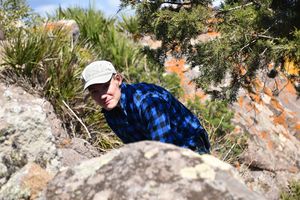Prehistoric Mining in Sardinia - Mining and Raw Materials Archaeological Research Approaches to Resource Appropriation using the example of the Sulcitana
The Research Project

In the context of my doctoral thesis, I would like to attempt to reconstruct a prehistoric lifeworld in southwestern Sardinia based on archaeological remains that are intended to serve as proxies for production (e.g. stone tools & technical ceramics) and consumption (e.g. metal objects) in early societies. In addition to archaeological artefacts, both scientific analyses of raw materials and theoretical concepts of appropriation and practice theory shall be used to develop hypotheses on potentials, practices and subsistence strategies within an early mining landscape.
Metallurgy, raw material networks and related provenance studies have long been a focus of Mediterranean prehistory and early history research.
Due to its geographical location, Sardinia plays a special role as a link between the Italian mainland, Sicily, North Africa, the Iberian Peninsula and the southern coast of France. Not least because of its relative abundance of raw materials - especially polymetallic lead, copper, zinc and silver ores, but also gold, iron and tin - the Mediterranean island has been the focus of archaeometrical-metallurgical research efforts for many years.
Despite their extraordinary importance for the prehistory and early history of the Mediterranean, both the processes of raw material extraction and the metallurgical chaîne opératoire in Sardinia have not yet been adequately researched.
The aim of the dissertation project is to gain insights into prehistoric resource appropriation using the example of the Sulcitana region (south-west Sardinia) and thereby develop concepts for early landscape use.
The surrounding area of the municipality of Santadi, located in the south-west of the province of southern Sardinia, represents a promising study area according to first impressions. Archaeological excavations in the Monte Meana cave south of Santadi have already provided clear evidence of Early to Middle Bronze Age (2100 - 1600 BC) metallurgy and - in combination with silver and copper finds from burial contexts from the Chalcolithic (2700 BC) to the Late Bronze Age (1400 BC) - possibly indicate a higher degree of processes of raw material appropriation and processing in the region. Indirect evidence of mining activities is also provided by hundreds of stone tools that are kept in the museums of Cagliari, Carbonia and Santadi. Empirical studies in the museum archives and a systematic classification of the stone tools should therefore provide a first material basis for mining-archaeological investigations in the region of south-west Sardinia.
However, although resource appropriation is the most direct way of interacting with the environment, such actions have been painfully neglected in Sardinian research. Generally, strategies of resource procurement in prehistoric times are considered pragmatic and less competitive, while metallurgy is associated with a strong ritual charge as well as status symbolism. The planned studies could undoubtedly contribute to verifying or falsifying such axioms - for it is precisely the relationships between mining, metallurgy, ritual and nutritional strategy that are to be considered in this dissertation project and thus contribute to the development of theses on the prehistoric landscape use of Sardinia. Furthermore the integration of landscape archaeological concepts is intended to embed the work in a theoretical context beyond a purely empirical research approach.
What I need the IRB for
With the support of the IRB, I would like to take the opportunity to engage in conversation with other international researchers working on Sardinia to develop collaborative ideas and concepts. The IRB enables me to take the initiative and establish in-person contacts while working and travelling on Sardinia. In addition, the IRB provides the possibility to react to invitations or research opportunities at short notice, while also granting me the flexibility to adjust my plans according to my work progress and research developments.
IRB funded activities
Research Stay at Museo Archeologico Villa Sulcis in Carbonia (Sardinia), May 2023
From May 7th to May 28th of 2023, I was able to spend my first IRB-funded research stay in Sardinia. With permission of the archaeological superintendence, it was possible to document archaeological finds from the archive of Museo Archeologico Villa Sulcis in Carbonia. Most of these finds are stone tools attributed to the locality of Su Fossu Tundu and have received little attention in research so far. In addition to the detailed documentation of these objects – that could provide vital information about prehistoric resource procurement techniques in south-western Sardinia – I have taken the opportunity to meet local scientists and thereby expand my own research network. After visits to Prof. Paolo Valera at the Geology Faculty of the University of Cagliari and to Dr. Carla Perra – director of the Sistema Museale di Carbonia (SiMuC) and the excavation of the Nuraghe Sirai – there are now opportunities for a guest residency at the University of Cagliari as well as access to further archaeological find complexes that would be very beneficial for my personal research.
Workshop participation and fieldwork (Sardinia), autumn 2023
In autumn 2023 – from 28th of September to 5th of October – my IRB grant enabled me to spend a short stay on Sardinia to participate in the four-day international workshop "New approaches to unveil the role of Sardinia in the Bronze Age metal trade from Scandinavia to the Levant". The workshop was hosted by the University of Gothenburg, the University of Cagliari and the Moesgaard Museum (Århus) and offered the opportunity to exchange ideas with numerous experts in archaeometry, archaeometallurgy and Sardinian archaeology.
In addition to discussing the preliminary findings of my research and developing my scientific network, I was also able to commit a few days to fieldwork and prospecting in the Nuxis area, focusing on gathering further insights into the region's potential for prehistoric mining activities.


